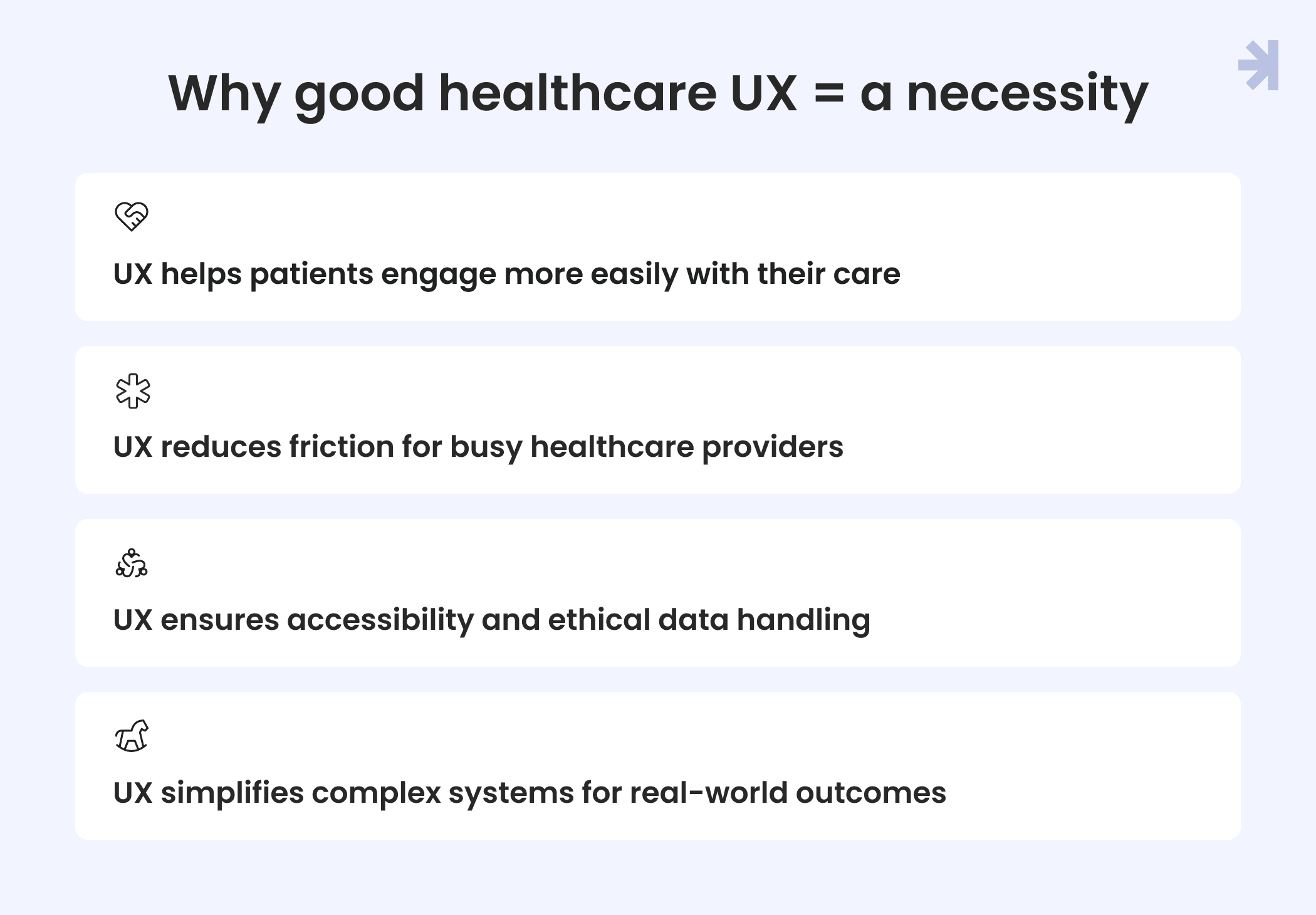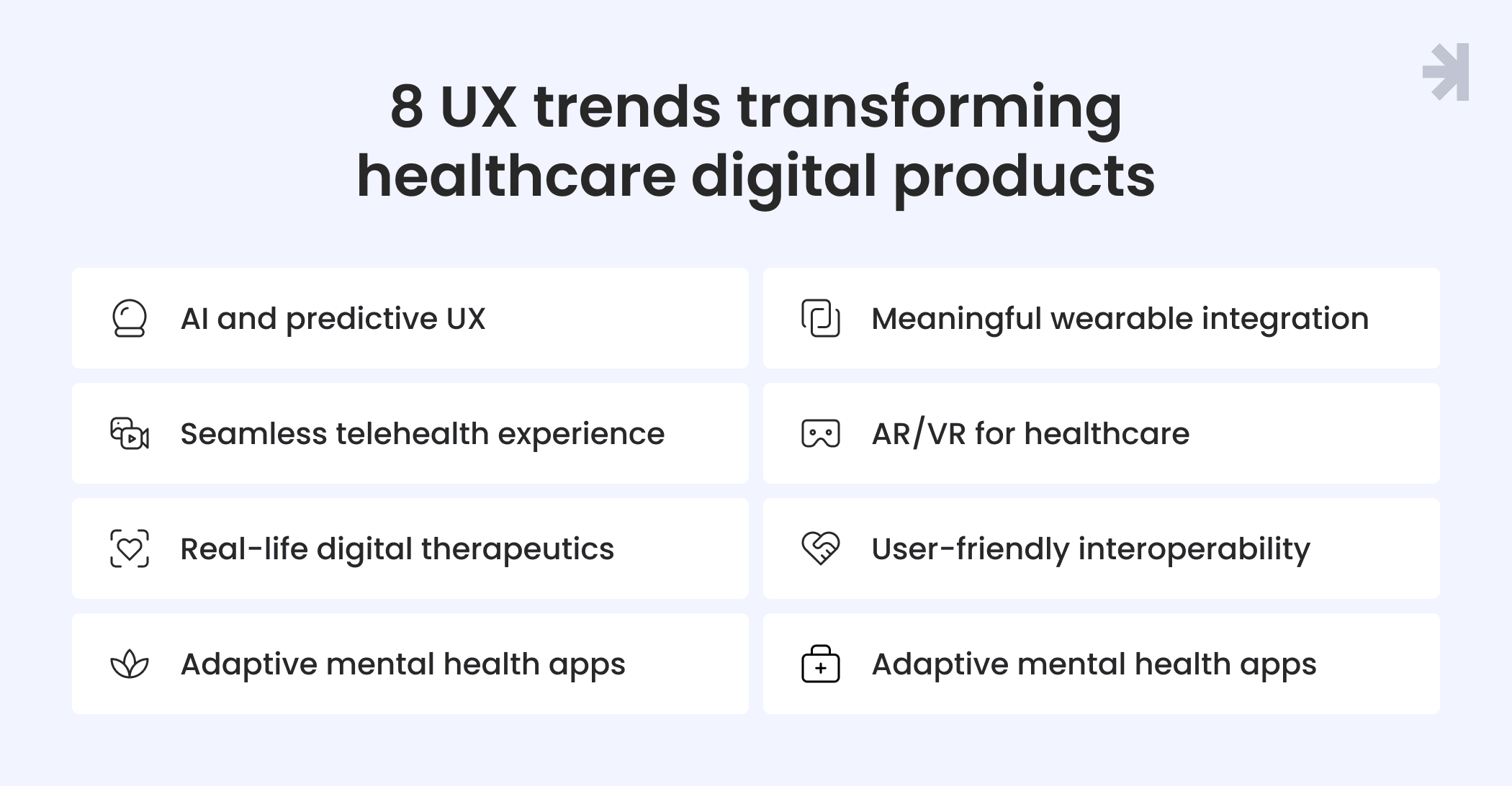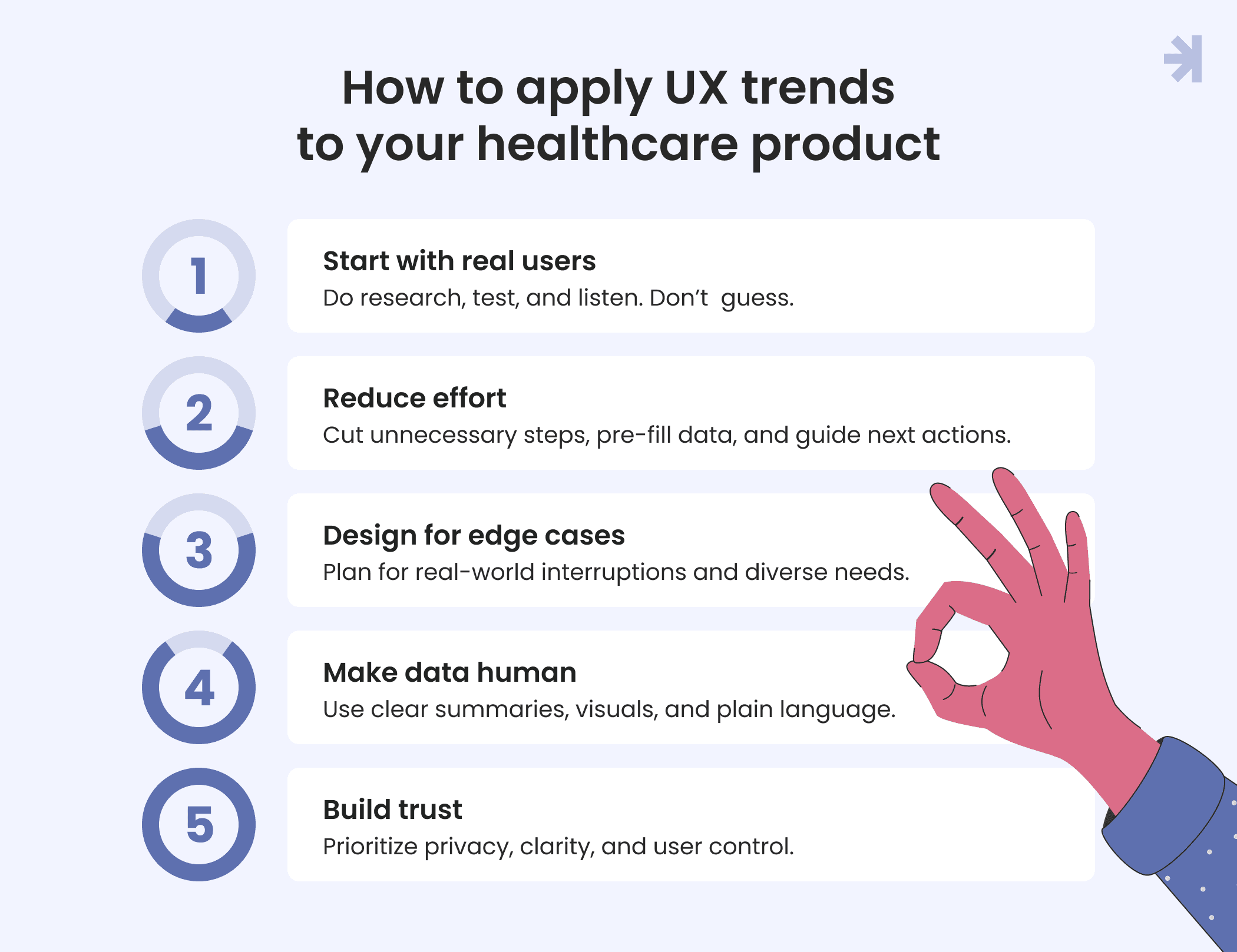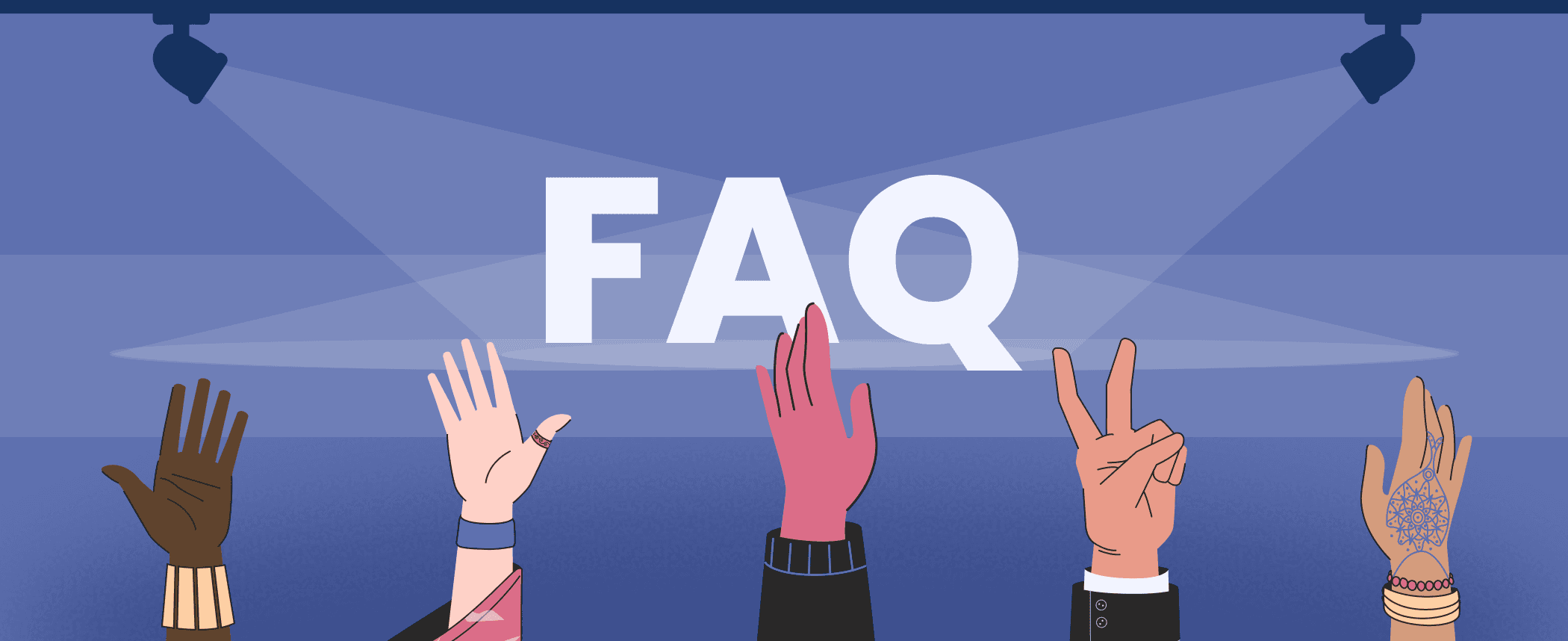In healthcare, friction is dangerous. Every second spent struggling with a confusing interface = a second stolen from care.
Every tap, scroll, or login that doesn't work as expected adds weight to already overburdened patients and clinicians.
In 2025, digital healthcare tools are everywhere. Mental health apps. Mobile-first care platforms. Smart dashboards for remote teams. The tech keeps advancing. But too often, the experience still feels like a puzzle people have to solve on their own.
That's where UX design makes the difference. The healthcare technology trends don't only deal with aesthetics. They help reduce burnout, increase access, and restore clarity in moments that matter most. In this article, we show 8 UX trends that redefine how healthcare feels and functions. You'll see how smart UX can:
- Lighten the load for busy clinicians
- Give patients more clarity in hard moments
- Help product teams build custom healthcare solutions that feel natural
Let’s start!
Key Takeaways
- AI in UX puts the right info in front of people at the right time, without extra noise.
- Wearable design highlights what matters most and makes health data easy to act on.
- Telehealth UX focuses on simple entry points, smooth flows, and human connection.
- AR and VR bring learning and guidance into the experience in a clear, purposeful way.
- Digital therapeutics use friendly onboarding, small steps, and clear progress to keep people engaged.
- Interoperability work in UX creates one view, fewer clicks, and a smoother path through complex systems.
- Mental health app design adapts to each person’s state, with quick access to the right kind of help.
- At-home test UX guides every action, tracks progress, and explains results in everyday language.
Why good healthcare UX design plays a critical role in 2025

It's a mistake to think that the only goal of healthcare UX is to make things look good and clean. The truth is, it is also to make care feel possible for people on both sides of the screen.
When the experience is simple and intuitive, people get the help they need faster. When it’s not, frustration takes over. And that frustration can cost time, energy, and sometimes even safety.
Let’s look at what good UX makes easier in 2025 (and why it plays a crucial role in connecting technology with care!)
UX helps patients engage more easily with their care
Confusing interfaces push people away. Thoughtful ones invite them in.
Clear navigation, plain language, and just-right guidance help patients schedule appointments, refill prescriptions, or check results without second-guessing themselves. Instead of feeling overwhelmed while using a patient portal, they feel in control.
When people understand what’s happening and what to do next, they’re more likely to follow through.
UX reduces friction for busy healthcare providers
Most clinicians don’t need more features. They need fewer clicks.
A well-designed tool clears the noise so providers can focus on the patient, not the interface. That means faster documentation, clearer data, and smoother workflows across teams.
Good UX gives time back. And in the healthcare sector, that time really counts.
UX ensures accessibility and ethical data handling
Real healthcare UX is built for everyone, not just the people who can tap fast and read fine print.
It works for patients with low vision. People using assistive tech. Those reading in a second language. It also respects consent and patient privacy at every step, showing what data is being used, why, and how to control it.
Accessibility = care.
UX simplifies complex systems for real-world outcomes
Healthcare is complex behind the scenes. But that complexity shouldn’t show up on the screen.
When showing test results, syncing wearable data, or managing care plans, good UX reduces cognitive load. It turns dense information into digestible insights. It makes the hard stuff feel manageable, and sometimes even easy.
Because a tool that makes sense gets used, and that's where patient outcomes start to improve.
8 UX trends transforming healthcare digital products

Yes, these trends are shaping what digital health solutions look like. But more importantly, they’re changing how care feels.
They focus on clarity, ease, and trust. When applied well, they help real people in real moments: patients trying to manage their health, clinicians navigating complex systems, teams rolling out new products that actually get used.
Let’s walk through what’s defining healthcare UX in 2025.
1. AI, personalization, and predictive UX
AI is finally earning its place in design. And not as a gimmick, but as a quiet assistant behind the scenes. In healthcare, smart systems now adapt in real time based on user behavior, medical history, or context.
That means fewer irrelevant alerts. Shorter paths to the right information. Custom content and recommendations based on actual user needs.
Predictive UX helps patients stay on track with their care. It nudges, reminds, suggests. Without being pushy. And for healthcare professionals, it means more efficient tools that surface what matters most, when it matters.
Done right, AI doesn’t take over the experience. It makes it feel more personal and aligned with individual patient needs, reinforcing the principles of user-centered design.
2. Wearable integration that delivers meaning, not just numbers
Wearables and connected medical devices are everywhere: glucose monitors, smart inhalers, sleep trackers, heart-rate sensors. The Internet of Medical Things (IoMT) has made real-time health tracking a reality. But without strong UX, all that data becomes noise.
In 2025, wearables UX means clarity and calm. Patients need:
- Clean dashboards that highlight what’s important
- Simple onboarding flows for device setup
- Smart notifications that nudge without overwhelming
- Feedback loops that explain what the data means and what to do next
And for clinicians, remote monitoring tools must slot easily into workflows. No toggling. No guessing. Just detailed data that helps them improve diagnostic accuracy and respond in real time.
The more connected devices we introduce, the more intentional the experience has to be.
3. Remote monitoring and telehealth that feel seamless
Telehealth services are now a permanent part of medical care. But most platforms still feel clinical in all the wrong ways: cold, glitchy, or impersonal.
UX in 2025 is shifting toward warmth and ease. That means:
- One-tap session access (no confusing logins)
- Thoughtful loading and waiting states
- Shared note-taking and visuals during calls
- Natural audio and video defaults that work without user setup
It also means designing for emotional moments. A cancer diagnosis over video. A mental health check-in after a tough week.
The interface design should never get in the way. It should support the moment with care.
When virtual care feels more human, people are more likely to return, open up, and follow through.
4. AR/VR and immersive experiences for education and accessibility
AR and VR aren’t for gaming anymore. They’re showing up in rehab sessions, patient onboarding, and surgical planning.
In healthcare user experience, immersive tools help people:
- Understand anatomy in 3D
- Practice exercises with visual guidance
- Navigate stressful procedures with calming walkthroughs
- Improve accessibility for those who benefit from spatial or multi-sensory input
These digital tools are still emerging, but they’re already proving useful where traditional screens fall short. They also showcase how the UX industry is pushing innovation forward while keeping humanity at the center.
The key to designing them well? Keep the experience purposeful. Not flashy. Every movement, transition, and prompt should help users feel informed, safe, and in control.
5. Digital therapeutics designed for real life
Digital therapeutics (DTx) are prescribed digital programs for conditions like diabetes, insomnia, or depression. In 2025, they are getting more and more common.
The UX challenge, and the trend in 2025, is making them easy to start and stick with. Strong DTx experiences:
- Use onboarding to explain the treatment clearly and set realistic goals
- Break exercises into short sessions that fit into a busy day
- Show progress in a way that feels encouraging, not clinical
This approach increases adherence. It turns medical advice into sustainable habits.
6. Interoperability and data sharing with the user in mind
One of the biggest friction points in digital healthcare? Siloed tools that don’t talk to each other. People shouldn’t have to bounce between systems to get a full picture of care. Clinicians shouldn’t need three dashboards open to prep for one appointment.
In the era of digital transformation in healthcare, the best UX work happens between systems. Where integration feels invisible and information flows naturally. That means:
- Context-aware interfaces that pull in relevant patient information
- Embedded APIs that bring third-party services into core flows
- Unified dashboards that reduce context switching
- Data syncing that feels instant and reliable
For patients, this results in:
- A single view of results, prescriptions, and care plans from multiple providers
- Easy ways to share records without repeated forms
For clinicians, this results in:
- Dashboards that update instantly when new information arrives
- Search and filters that surface what matters most for the current case
Interoperability is often a technical challenge. But the payoff shows up in the UX when the system supports the user, not the other way around. Integration helps healthcare systems function as cohesive experiences instead of fragmented tools.
7. Mental health apps that respond to real needs
Mental health care is deeply personal. A generic experience often misses the mark. The current trend is toward tools that adapt in real time to each person’s situation.
Good UX here means healthcare applications that listen and adjust:
- Daily check-ins that adapt questions and suggestions based on mood, stress, or sleep patterns
- Crisis help that’s instantly visible on the home screen, with direct access to hotlines or chat support
- Progress views that celebrate small steps forward and help people stay motivated over time
Tone matters. The language should be gentle, non-judgmental, and encouraging. Privacy is critical. Clear consent, transparent data use, and easy-to-find settings build the trust that keeps people coming back when they need help most.
8. At-home diagnostics people can follow with confidence
Home testing (like DNA kits, blood biomarkers, and mail-in lab work) is now part of routine healthcare. But for many, it’s unfamiliar territory. The design challenge is to remove uncertainty at every step.
Strong UX guides people from start to finish:
- Step-by-step visuals that make each stage impossible to get wrong
- Real-time updates on when the lab receives the test and when results will be ready
- Reports in plain language that explain what the results mean, why they matter, and what to do next
When the process feels simple and the results are clear, people take action sooner. They book a follow-up appointment, make a lifestyle change, or begin treatment without delay. That’s where good design directly impacts health outcomes.
How to apply these trends to your healthcare product

Healthcare industry trends only matter if they move the needle for real people.
These shifts are here to solve specific pain points across patient and clinician journeys (ideally worked on by UX designers and UX professionals who’ve seen the real-life stress points).
Here’s how product teams can start turning ideas into better care experiences.
Start with real users, not assumptions
User interviews. Usability testing. Field user research.
Even the smartest design trend falls flat if it’s built in a vacuum. The best way to prioritize features and flows is by understanding what your users are actually trying to do and where they’re getting stuck.
Before you design, step into their shoes. Watch them use what already exists. Ask where they pause, what they ignore, and what stresses them out.
Good UX doesn’t come from guessing. It comes from listening.
Reduce effort, everywhere you can
Don’t add more steps. Remove the ones that don’t need to be there.
- Pre-fill forms with known data
- Let users skip or save progress
- Highlight the most likely next step
- Make help easy to find, right when it’s needed
If something can be simpler, it should be. Build digital healthcare tools people actually want to use again.
Design for edge cases from the start
Real life doesn’t follow a perfect flow. Especially in healthcare services.
Someone might lose access to their phone mid-check-in. A parent might need to book an appointment for their child. A clinician might need to switch context fast when a case escalates.
Designing for edge cases upfront makes your product stronger and more inclusive. It shows your team is thinking ahead. And thinking about people.
Make your data human
Vitals, trends, test results, medications… It's a lot. And it’s often written for systems, not humans.
Your job is to translate.
That could look like:
- Summaries instead of raw tables
- Color cues for change over time
- Simple explanations for complex terms
- Options to go deeper, but only when the user asks
Make it easy to understand what’s going on, what’s changed, and what to do next.
Build trust into every interaction
Trust doesn’t come from saying “we care.” It comes from design choices that feel honest, clear, and respectful of someone’s time and data.
That means:
- Robust privacy measures, clear settings, and consent flows
- Interfaces that explain why a step is needed
- Honest, human microcopy that never feels like a trap
- Options that give control, not confusion
If your product helps people feel safe, seen, and capable, they’ll come back to it.
Design your healthcare product with MagicFlux
Building great healthcare UX = solving real problems with care, intention, and clarity. That takes a design team who understands complexity and knows how to make it feel simple.
At MagicFlux, we design digital healthcare products that work for real people. We help product teams turn research into clarity, interfaces into confidence, and ideas into tools that improve patient care.
If you’re creating a healthcare experience that needs to feel safer, smarter, and easier to use, we’d love to help.
Let’s make something people can trust.
FAQs

What are the latest UX trends in digital healthcare?
Some of the top UI UX design trends 2025 include AI-driven personalization, meaningful wearable integration, seamless telehealth, immersive AR/VR for education, user-friendly digital therapeutics, interoperability-focused design, adaptive mental health apps, and clear at-home diagnostics experiences.
Why is UX design important for healthcare providers and medical professionals?
Good UX reduces friction in clinical workflows. It cuts down clicks, helps surface the right information fast, and saves time during high-pressure tasks. That support makes care more efficient and less stressful for the people delivering it.
How does UX design improve patient engagement and outcomes?
When tools are easy to use, people are more likely to follow through. Clear navigation, helpful prompts, and personalized experiences give patients more control over their care which leads to better habits, fewer drop-offs, higher user engagement, and stronger results.
What are the key challenges of UX design for healthcare products?
Healthcare tools are often complex under the hood. Designing them to feel simple without losing depth takes skill. Teams also face challenges like accessibility, medical data security, and designing for edge cases. And these all while making sure the experience works for a wide range of users.


